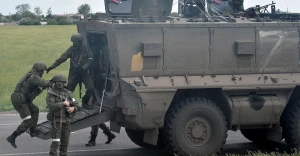
How Ukrainian simulators help troops master new weapons
Ukrainian simulators are helping soldiers quickly learn to use a wide range of new weapons, crucial for the fast-paced battlefield
Economichna Pravda writes about it.
Ukrainian companies like Logics7 are creating virtual reality (VR) simulators that fully mimic the operation of mobile air defense systems. These tools help soldiers practice complex scenarios, like shooting down missiles.
With hundreds of new weapons flooding into Ukraine, soldiers previously relied on YouTube tutorials to learn how to operate systems like the FIM-92 Stinger and FGM-148 Javelin. Now, advanced simulators allow them to train more effectively, mastering weapon functions and tactics faster.
The demand for training equipment has surged since 2022, with both long-established manufacturers and new IT companies entering the market. Simulators help reduce costs by allowing virtual training instead of using expensive ammunition and logistics at shooting ranges.
One popular option is laser-based simulators that project battle scenarios on large screens. Soldiers use mock weapons with realistic weight and feel, while infrared cameras track their shots. This setup allows group training, with instructors analyzing performance and strategies.
Although simulators can’t replicate the sounds and adrenaline of live combat, they effectively teach weapon handling and tactical decision-making Logics7 noted that “new recruits, unfamiliar with certain weapons, can train in small centers near the front line until they’re fully prepared.”
VR simulators also allow mobile air defense teams to practice in realistic scenarios, coordinating between commanders, gunners, and shooters. This teamwork-focused training improves their effectiveness in combat.
Simulators are also vital for drone operator training, minimizing the loss of real drones during practice. However, developing simulators for aircraft-type drones is more complex, as it requires access to technical data from manufacturers.
The Ukrainian market for military simulators is growing rapidly, with buyers ranging from the state and military units to schools and foreign partners. Logics7’s revenue reportedly increased tenfold between 2022 and 2023.
However, Ukrainian manufacturers face challenges. Export restrictions since 2022 limit international sales, and domestic factories are underutilized. Competing globally is tough, as Western arms giants dominate the $13.41 billion military simulator market. Yet, Ukrainian firms see opportunities in niche markets, especially in developing countries.
- News













































